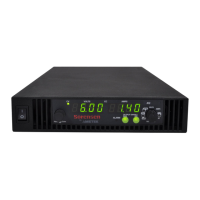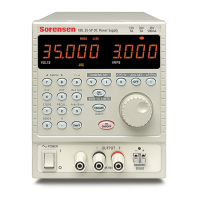SCPI Command Reference
M370430-01 Rev B A-5
The following punctuation is not sent with the command string:
Braces ({ }), or curly brackets, identify a selection of choices.
Choose one of the enclosed values.
Vertical bars, or pipes, ( | ) can be read as “or” and is used to
separate the choices found within the braces.
Angle brackets ( < > ) identify where specific values must be
entered for a parameter. For example, in the example at the top of
the page, the parameter <current> appears in the command string.
To set the current set point to 0.1 A, the syntax is CAL:CURR:LEV
0.1.
Square brackets ( [ ] ) identify optional parameters. If an optional
parameter is not sent with the command string, a default parameter
is sent in its place.
Using Minimum and Maximum
In the following example, Minimum and Maximum are offered as
alternative choices to declaring a specific parameter value.
CAL:CURRent:LEVel {<current>|MIN|MAX}
The string CAL: CURR: LEV MIN sets the current calibration level to
the minimum model value.
Using Queries
A question mark lets you query the present value for most
parameters. For example, to query the current calibration state use:
CAL:SEC:STAT?
You can also use the following to query minimum and maximum
allowed values for most parameters:
:VOLT? MIN
:VOLT? MAX
Important: If you send two queries, it is best to read and respond to the first
response before trying to read the second. Otherwise, you may receive an
incomplete first response followed by a complete second response. To avoid
this, you can either wait for and read the first response before sending the
second query, or send a device clear message before sending the second query.

